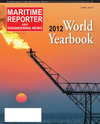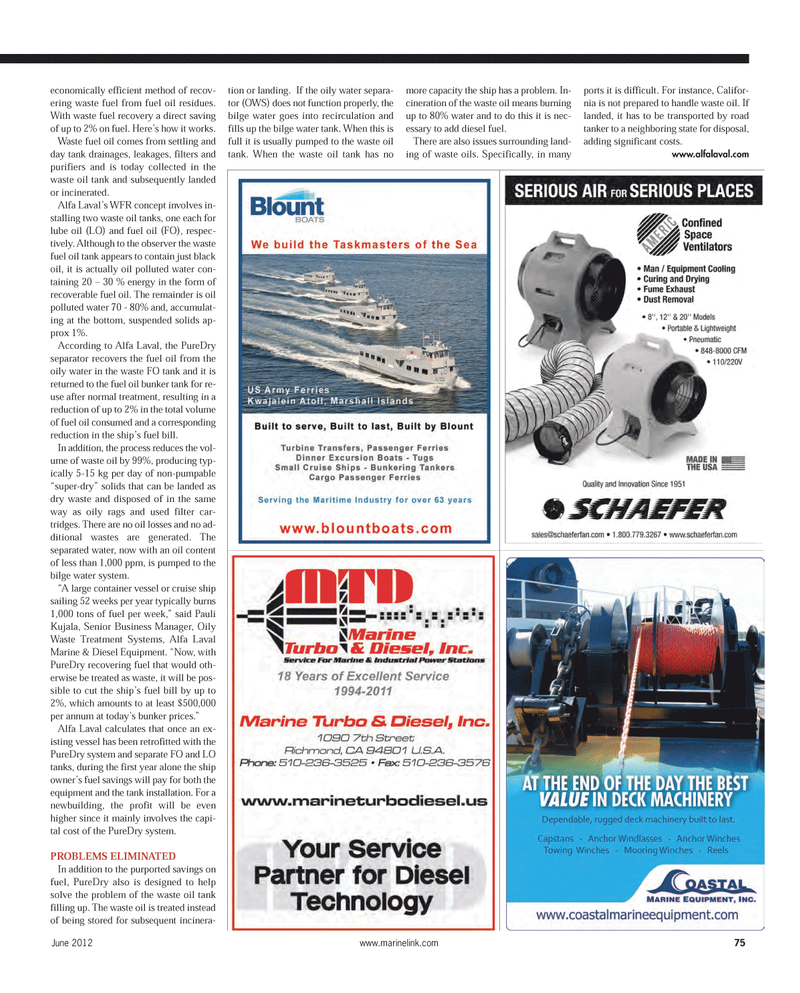
Page 75: of Maritime Reporter Magazine (June 2012)
Annual World Yearbook
Read this page in Pdf, Flash or Html5 edition of June 2012 Maritime Reporter Magazine
economically efficient method of recov- ering waste fuel from fuel oil residues. With waste fuel recovery a direct saving of up to 2% on fuel. Here?s how it works. Waste fuel oil comes from settling and day tank drainages, leakages, filters and purifiers and is today collected in the waste oil tank and subsequently landed or incinerated. Alfa Laval?s WFR concept involves in- stalling two waste oil tanks, one each for lube oil (LO) and fuel oil (FO), respec-tively. Although to the observer the waste fuel oil tank appears to contain just blackoil, it is actually oil polluted water con- taining 20 ? 30 % energy in the form of recoverable fuel oil. The remainder is oil polluted water 70 - 80% and, accumulat- ing at the bottom, suspended solids ap-prox 1%. According to Alfa Laval, the PureDry separator recovers the fuel oil from the oily water in the waste FO tank and it is returned to the fuel oil bunker tank for re- use after normal treatment, resulting in areduction of up to 2% in the total volume of fuel oil consumed and a correspondingreduction in the ship?s fuel bill. In addition, the process reduces the vol- ume of waste oil by 99%, producing typ- ically 5-15 kg per day of non-pumpable?super-dry? solids that can be landed as dry waste and disposed of in the same way as oily rags and used filter car- tridges. There are no oil losses and no ad- ditional wastes are generated. The separated water, now with an oil content of less than 1,000 ppm, is pumped to thebilge water system. ?A large container vessel or cruise ship sailing 52 weeks per year typically burns 1,000 tons of fuel per week,? said Pauli Kujala, Senior Business Manager, Oily Waste Treatment Systems, Alfa Laval Marine & Diesel Equipment. ?Now, with PureDry recovering fuel that would oth- erwise be treated as waste, it will be pos- sible to cut the ship?s fuel bill by up to 2%, which amounts to at least $500,000per annum at today?s bunker prices.? Alfa Laval calculates that once an ex- isting vessel has been retrofitted with the PureDry system and separate FO and LOtanks, during the first year alone the ship owner?s fuel savings will pay for both the equipment and the tank installation. For a newbuilding, the profit will be even higher since it mainly involves the capi- tal cost of the PureDry system. PROBLEMS ELIMINATED In addition to the purported savings on fuel, PureDry also is designed to helpsolve the problem of the waste oil tank filling up. The waste oil is treated instead of being stored for subsequent incinera- tion or landing. If the oily water separa- tor (OWS) does not function properly, the bilge water goes into recirculation and fills up the bilge water tank. When this is full it is usually pumped to the waste oil tank. When the waste oil tank has no more capacity the ship has a problem. In-cineration of the waste oil means burning up to 80% water and to do this it is nec- essary to add diesel fuel. There are also issues surrounding land-ing of waste oils. Specifically, in many ports it is difficult. For instance, Califor- nia is not prepared to handle waste oil. If landed, it has to be transported by roadtanker to a neighboring state for disposal, adding significant costs. www.alfalaval.com June 2012www.marinelink.com 75MR June12 # 10 (74-80):MR Template 6/13/2012 11:46 AM Page 75

 74
74

 76
76
